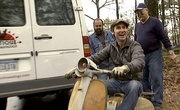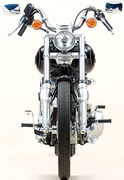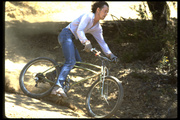
Despite slumping sales in the United States during 2016, motorcycles are having a moment. According to a recent article in the “New Yorker,” a number of Silicon Valley plutocrats have made motorcycles key components of their preparations for Armageddon, be it biblical, biological, radiological, climatological, or the result of good-old-fashioned populist rage. These well-heeled survivalists have figured out that when the end times come and the freeways clog with Teslas and Priuses heading for the hills, a motorcycle might be the only way to get out of town alive. In this grim scenario, the motorcycle is the killer app, enabling digital disruptors and their spouses clutching them tight to zigzag through even the worst “Road Warrior” landscapes to the safety of their heavily armed and copiously stocked bunkers, located precisely a gas tank of fuel away (“Good luck, kids!”).
“I really doubt that Steve McQueen would have copped to the notion of being a collector.”
As two-wheeled vehicles designed primarily for single riders, motorcycles have long been symbols of independence, freedom, and escape, but they haven’t always been so directly aligned with unbridled selfishness. In fact, motorcyclists are preternaturally social creatures, whose communities run the gamut from the local chapter of Hells Angels revving their roaring Harleys to a group of senior citizens taking their purring Gold Wings out for a Sunday ride.
Steve McQueen (1930-1980) belonged to neither of these clans, but according to McQueen’s Motorcycles: Racing and Riding with the King of Cool, written by former “Motor Trend” executive editor Matt Stone, McQueen loved motorcycles for their sense of community. Oh sure, McQueen rode Triumphs and Huskys hard for the thrill of going crazy fast, but he was also into bikes to bask in the bonhomie of like-minded motorheads.

Top: Steve McQueen on his Norton Commando during the filming of “Le Mans” in 1970. McQueen family photo. Above: It doesn’t get cooler than a Bud Ekins frame around a personalized McQueen license plate. Photo by Matt Stone. Both images from McQueen’s Motorcycles.
The two most important motorheads in McQueen’s cycling circle were the brothers Dave and Bud Ekins, the latter of whom owned a Triumph and Honda dealership in Sherman Oaks, California, not too far from McQueen’s home in the Hollywood Hills. “Those guys were brothers to him, and vice versa,” Stone told me when we spoke recently over the phone.
When McQueen met the Ekins brothers, he was a rising star, an actor who had made a name for himself in “The Magnificent Seven” but was not yet world famous for the role he would shortly play as the motorcycle-riding prisoner of war in “The Great Escape” (1963). The Ekins shop was perfect for a guy like Steve McQueen, who as a 12-year-old had helped a friend put a Ford V8 engine into an Allard J2 roadster, and as a 17-year-old in the Marine Corps had even tried to soup up one of his company’s tanks to see if he could get it to go any faster. For the record, it could not because, well, it was a tank.

This is probably a publicity shot, taken in 1961, of McQueen posing on a Honda CA77 Dream. Photo by PhotoFest, from McQueen’s Motorcycles.
In hindsight, it seems almost inevitable that Steve McQueen would find his way to the Ekins motorcycle dealership. Like McQueen, Bud was born in 1930, and spent time as a teenager in a reform school. In addition, the Ekins brothers were racers—McQueen almost chose a career as a race-car driver before an ultimatum from McQueen’s movie studio, United Artists, forced him to pursue acting full time. And most important of all, the Ekins brothers and the mechanics who worked in Bud’s shop lived and breathed bikes. McQueen did, too, which was more important to all concerned than McQueen’s glamorous day job. “Bud was not especially impressed with the Hollywood scene,” Dave Ekins writes in his foreword to McQueen’s Motorcycles, “so it was easy for celebrities to come and go as they pleased without any special attention brought to them.” For McQueen, the Ekins dealership became an escape from the pressures of celebrity, a home away from home where he didn’t have to hide behind a pair of Persol sunglasses in order to be cool.
Before long, the Ekins brothers had introduced McQueen to the rigors and pleasures of amateur, off-road motorcycle racing in the American Motorcycle Association’s tough and competitive District 37 Division, which includes much of Southern California’s Mojave Desert. “There was a camaraderie in the desert among Bud, Steve, and me,” Dave Ekins writes in McQueen’s Motorcycles. “We only raced for trophies and, if Steve fell down, there were no movie execs to fuss over him. The courage it took to be an actor and to race was central to Steve McQueen’s life: He put himself out there on the stage as an actor and also risked it all for the thrill of racing with a bunch of regular guys. He was one of us.”

“The Great Escape” was shot in Germany in 1962 and released in 1963. It was McQueen’s big breakthrough as a star. Via Heritage Auctions.
This closeness led McQueen to tap Bud as his stunt double for “The Great Escape,” which like “The Magnificent Seven” was directed by John Sturges. Filmed in Germany in 1962, “The Great Escape” was released to great acclaim the following year. According to McQueen’s biographer, William Nolan, McQueen made sure “The Great Escape” would have plenty of motorcycle scenes for himself and Bud. “John and I worked a hairy motorcycle chase into the script,” McQueen told Nolan for his book, Star on Wheels. “By inserting this cycle sequence into ‘The Great Escape,’” Nolan wrote, “Steve had outfoxed the studio; now the executives had no choice. Steve would race. On film, and at their risk.”
In the end, Ekins, who died in 2007, would spend three months in Germany shooting “The Great Escape,” and he would continue to double for McQueen throughout the actor’s too-short career (McQueen died of mesothelioma in 1980). But as Ekins told Matt Stone in an interview, McQueen did most of the motorcycle riding captured in “The Great Escape” himself. “I really didn’t do much of it,” Ekins said. “Anything where he may get hurt, that’s what I did. There’s a chase sequence in there where the German stunt riders were after him, and he was so much a better rider than they were, that he just ran away from them. So, they put a German uniform on him and he chased himself! I rode as a German soldier too, but he chased himself several times in the movie.”

A 2006 exhibition at the Peterson Automotive Museum in Los Angeles featured a blowup of the famous motorcycle jump by Bud Ekins in “The Great Escape,” paired with a facsimile of the actual Triumph used in the movie. Ekins sold the original to a stuntman, and its whereabouts remain unknown. Photo by Matt Stone, from McQueen’s Motorcycles.
Naturally, all that chasing was performed on Triumphs with factory engines. “I was running a forty-cubic inch [650cc] Triumph TT special,” McQueen told Nolan. “We painted it olive drab and put on a luggage rack and an old seat to make it look like a wartime BMW. The first time we tried out the bikes at full chat the Bavarians just gaped, open-mouthed. The didn’t believe a bike could go that fast over this kind of uphill-downhill terrain.”
The most famous scene in the film is the one near the end, in which McQueen’s character tries to jump a 60-foot barbed-wire fence. Ekins did the honors for that one, jumping a fence whose barbs were actually made out of rubber bands for the cyclist’s safety. As for the bike? “I sold it to a stuntman,” Bud Ekins told Stone. “I didn’t tell him it was the bike from ‘The Great Escape.’” The stuntman sold it, too, and the most famous motorcycle in cinema was quickly lost to the mists of history.
In the years that followed, McQueen honed his cycling chops, at one point even riding with the Ekins brothers and three other pros as a member of the International Six Days Trial team in what was then East Germany. Again, Triumphs were pressed into service, and again, McQueen earned the respect of his motorhead peers. McQueen also continued riding in the desert, often under the pseudonym Harvey Mushman in an attempt to avoid needless attention.

McQueen in his element in the parking lot of the Bud Ekins motorcycle dealership. The cast on his wrist puts this photo as circa 1964, just before he competed in the International Six Days Trial in what was then East Germany. Neile Adams McQueen collection, from McQueen’s Motorcycles.
And, of course, McQueen made lots of movies, nine more alone in the 1960s after “The Great Escape.” Not coincidentally, some of these films—“Bullitt” from 1968 comes to mind—allowed McQueen to drive cars really really fast. That visceral thrill, as well as the actor’s insistence that he do most of his own stunts, is what made the chase scenes in McQueen’s movies feel so real. For McQueen, this willingness to put himself out there, as Dave Ekins puts it, ennobled the work of acting. It was also good for the box office, which is why by the early 1970s, the former reform-school kid was the highest paid actor in Hollywood.
In a way, though, the McQueen narrative always comes back to “The Great Escape.” While McQueen had liked the film’s story and the character he got to play, an equally important aspect for him was its depiction of motorcycling in movies. As he told Robert F. Jones of “Sports Illustrated” in 1971, “Most bike flicks in the past concentrated on the outlaw crap. Brando’s movie ‘The Wild One’ in the early 1950s set motorcycle racing back about 200 years.”

As this “Sports Illustrated” cover from 1971 shows, McQueen was in good shape into his 40s. Here he’s riding the Husqvarna 400 filmed in Bruce Brown’s documentary “On Any Sunday.” Via Sports Illustrated.
By 1971, McQueen’s passions for motorcycling and moviemaking would come together again in the form of a documentary called “On Any Sunday.” Directed by Bruce Brown, whose “Endless Summer” in 1966 had introduced general audiences to surfing, “On Any Sunday” did the same for motorcycle racing. Co-produced by McQueen, who also had an uncredited starring role, the film follows motorcycle-racing legends Mert Lawwill and Malcolm Smith. The documentary included McQueen’s 1970 run of the Elsinore Grand Prix, when the actor finished eighth in a field of 500—and with a broken foot, no less.
It was also during the 1970s that McQueen’s reputation as a motorcycle collector grew, although author Matt Stone says the word “gatherer” better describes the more than 200 motorcycles that passed through his various garages over the decades. “I really doubt that Steve McQueen would have copped to the notion of being a collector,” Stone says. Still, McQueen’s Motorcycles is filled with images of vintage Harleys, Indians, Pierces, and Popes that ended up bringing top dollar at auction after his death, in no small part because McQueen once owned them.

The great car and motorcycle customizer Von Dutch painted the wrong date on this 1929 Scott Super Squirrel. Before his death, McQueen gave the rare bike to Von Dutch as a gift. Via Antiquorum.
Except when they didn’t. A case in point was McQueen’s rare, 1929 Scott Super Squirrel, hand painted by the great hot rod and motorcycle customizer Von Dutch. In terms of raw value, it was easily one of the top prizes in McQueen’s collection, but before his death, McQueen gave this museum piece to Von Dutch as a gift.
McQueen’s life was filled with such acts of generosity—for him, a motorcycle could never be just a two-wheeled hedge against a traffic jam at the end of days. The Von Dutch anecdote also suggests that McQueen, who was comfortable riding familiar motorcycle brands fitted with factory engines, appreciated the work of a good customizer, too. That may have been true when it came to an innovator like Von Dutch, but Stone isn’t convinced McQueen would have looked kindly on today’s celebrity-driven, custom-motorcycle shops, as practiced by publicity-hungry enterprises like Orange County Choppers. “I don’t think McQueen would have bought into that scene at all,” Stone says. After all, for a guy like Steve McQueen, it was all about the joy of riding, preferably with friends. Calling attention to oneself with a fancy McQueen-branded bike just wouldn’t have been cool.
(“McQueen’s Motorcycles: Racing and Riding with the King of Cool” is available from Amazon. If you buy something through a link in this article, Collectors Weekly may get a share of the sale. Learn more.)

 Harley-Davidson, Before and After the Knucklehead
Harley-Davidson, Before and After the Knucklehead
 American Picker Dream, Part II: Mike Wolfe On Enduros and Land Rockets
American Picker Dream, Part II: Mike Wolfe On Enduros and Land Rockets Harley-Davidson, Before and After the Knucklehead
Harley-Davidson, Before and After the Knucklehead The Hippie Daredevils Who Were Just Crazy Enough to Invent Mountain Biking
The Hippie Daredevils Who Were Just Crazy Enough to Invent Mountain Biking Honda MotorcyclesSoichiro Honda started the Honda Technical Research Institute in 1946, to e…
Honda MotorcyclesSoichiro Honda started the Honda Technical Research Institute in 1946, to e… Triumph MotorcyclesThe first Triumph motorcycle was built in 1902, essentially a bicycle fitte…
Triumph MotorcyclesThe first Triumph motorcycle was built in 1902, essentially a bicycle fitte… MotorcyclesMotorcycles have figured prominently in just about every aspect of 20th-cen…
MotorcyclesMotorcycles have figured prominently in just about every aspect of 20th-cen… Mari Tepper: Laying it on the Line
Mari Tepper: Laying it on the Line Nice Ice: Valerie Hammond on the Genteel Charm of Vintage Canadian Costume Jewelry
Nice Ice: Valerie Hammond on the Genteel Charm of Vintage Canadian Costume Jewelry How Jim Heimann Got Crazy for California Architecture
How Jim Heimann Got Crazy for California Architecture Modernist Man: Jock Peters May Be the Most Influential Architect You've Never Heard Of
Modernist Man: Jock Peters May Be the Most Influential Architect You've Never Heard Of Meet Cute: Were Kokeshi Dolls the Models for Hello Kitty, Pokemon, and Be@rbrick?
Meet Cute: Were Kokeshi Dolls the Models for Hello Kitty, Pokemon, and Be@rbrick? When the King of Comedy Posters Set His Surreal Sights on the World of Rock 'n' Roll
When the King of Comedy Posters Set His Surreal Sights on the World of Rock 'n' Roll How One Artist Makes New Art From Old Coloring Books and Found Photos
How One Artist Makes New Art From Old Coloring Books and Found Photos Say Cheese! How Bad Photography Has Changed Our Definition of Good Pictures
Say Cheese! How Bad Photography Has Changed Our Definition of Good Pictures Middle Earthenware: One Family's Quest to Reclaim Its Place in British Pottery History
Middle Earthenware: One Family's Quest to Reclaim Its Place in British Pottery History Fancy Fowl: How an Evil Sea Captain and a Beloved Queen Made the World Crave KFC
Fancy Fowl: How an Evil Sea Captain and a Beloved Queen Made the World Crave KFC
Leave a Comment or Ask a Question
If you want to identify an item, try posting it in our Show & Tell gallery.